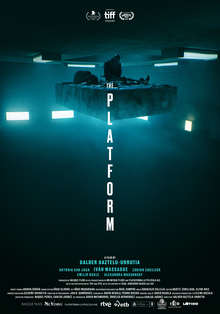
This is a small Spanish science-fiction film that has garnered quite a bit of international attention, especially after most of the world entered lockdown due to the ongoing pandemic. I think it’s more of a horror movie than science-fiction however and is more about slick presentation than meaningful substance. It is after the debut feature of Galder Gaztelu-Urrutia who before this directed commercials.
Goreng wakes up as a prisoner in a concrete cell with the number 48 inscribed on the wall. Sharing the cell with him is an older man named Trimagasi who explains to him the setup. They are in a tall tower with a central square-shaped hole running through each floor. Every day, a platform filled with food moves down the length of the tower, stopping at each floor so that the prisoners can eat. But this means that the ones on the upper floors eat first and the ones on the lower levels must settle for whatever is left. Every month, the prisoners are gassed to unconsciousness and moved to a different level. Things aren’t so bad at level 48 and the two become friends of a sort. But the next month, they are moved to level 171. Trimagasi, knowing that they can expect no food by the time the platform arrives at their level, has Goreng tied up before he wakes up and sadly explains that he will have to eat pieces of him to survive and will try his best to eat as little as possible and ensure he lives. Thus Goreng finally realizes the depths of the horror he has subjected himself to.
This is effectively a high-concept idea film, pitched to be as provocative and shocking as possible. This is the kind of scenario that I would enjoy watching in an episode of a show like Black Mirror or The Outer Limits but, expanded to full movie length, you’re forced to examine the deficiencies in its logic and worldbuilding more seriously. The social message is sound, if a little too on-the-nose. As one idealist in the film claims, there should be enough food for everyone in the tower if everyone, beginning with those at the top, eats only their fair share. But the trouble is everyone doesn’t cooperate and those in the lower levels have no way to impose rules on those in the upper levels. To survive those at the bottom have no choice but to kill one another. Everyone understands that even if they’re at the top this month, they could still end up at the bottom next month but this realization isn’t enough to foster cooperation and so on those at the top happily celebrate their high status, temporary as it is, and gorge themselves as much as possible.
The problem is that the film isn’t even consistent in its messaging. Its social critique relies on the fact that there really is enough food for everyone but Goreng later proves that this is an incorrect assumption as the tower is far taller than he expected. This accentuates the horror aspect of the film but fatally undermines its assertion that cooperation can work. In fact, the longer the film goes on the more implausible the scenario becomes as it is impossible to believe how anyone could survive in the lowest levels for a whole month. The film itself provides a really dumb reason for Goreng to voluntarily enter the tower and doesn’t even attempt to provide answers about who built the tower and why they built it. Towards the end, the whole setup feels like a metaphor born out of a nightmare and not a literal physical place at all.
As a spectacle this is still riveting on a very visceral level. The juxtaposition of rich food and blood makes for powerful and primordial imagery. Trimagasi and his bleak philosophical musings on the essential savagery of humanity make for a wonderful foil to Goreng who is more inclined to altruism, even after death. I’m also amused that many of these names for the characters came from the Indonesian language for some reason. But in the end this is a film that is all about the shock and the horror and has very little substance behind it.